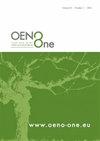Grape berry native yeast microbiota: advancing trends in the development of sustainable vineyard pathogen biocontrol strategies
IF 2.2
3区 农林科学
Q3 FOOD SCIENCE & TECHNOLOGY
引用次数: 0
Abstract
Grape berry is an ecological niche for a myriad of microbes, whose interactions with one another modulate fruit health and can play a role in fermentation, imparting character and distinctiveness to wines. With the growing concerns about and awareness of the risks associated with the overuse of chemical pesticides in viticulture, microbial-based pest control is increasingly encouraged as a more sustainable and environmentally friendly strategy. The use of yeasts from grape berries is a promising alternative for the control of vineyard diseases and their increasing acceptance is rapidly changing our perception of fungicides. In this paper, we provide an overview of the latest methodologies for characterising the dynamics of grape berry yeasts in the context of grape disease management, and discuss the prospects for their effective use as biocontrol agents in viticulture. Most research has focused on the control of fruit rots produced by Botrytis, Aspergillus, Colletotrichum and Penicillium spp. using formulations that comprise single strains of specific yeast genera, including Aureobasidium, Metschnikowia, Saccharomyces, Pichia, Candida and Rhodotorula. However, the challenging disparity between successful biocontrol outcomes obtained in vitro and their low applicability in the field is a major limitation for the large-scale implementation of these strategies. Novel research approaches for maximising the stability and efficiency of yeast-derived bioactives are discussed in this review.葡萄浆果原生酵母微生物群:可持续葡萄园病原体生物防治战略的发展趋势
葡萄浆果是无数微生物的生态位,它们之间的相互作用调节着果实的健康,并在发酵过程中发挥作用,赋予葡萄酒特色和独特性。随着人们对葡萄栽培中过度使用化学农药的风险日益关注和认识,基于微生物的病虫害防治作为一种更可持续、更环保的策略受到越来越多的鼓励。使用葡萄果实中的酵母菌是控制葡萄园病害的一种很有前景的替代方法,这种方法越来越被人们所接受,并迅速改变了我们对杀菌剂的看法。在本文中,我们概述了在葡萄病害管理中描述葡萄浆果酵母菌动态的最新方法,并讨论了在葡萄栽培中将其有效用作生物控制剂的前景。大多数研究都集中在利用由特定酵母菌属(包括 Aureobasidium、Metschnikowia、Saccharomyces、Pichia、Candida 和 Rhodotorula)单一菌株组成的制剂来控制由灰霉病菌、曲霉菌、壳针孢霉和青霉属产生的果实腐烂病。然而,在体外获得的成功生物防治结果与在实地的低适用性之间存在着巨大的差距,这是大规模实施这些策略的主要限制因素。本综述讨论了最大限度地提高酵母衍生生物活性物质的稳定性和效率的新研究方法。
本文章由计算机程序翻译,如有差异,请以英文原文为准。
求助全文
约1分钟内获得全文
求助全文
来源期刊

OENO One
Agricultural and Biological Sciences-Food Science
CiteScore
4.40
自引率
13.80%
发文量
85
审稿时长
13 weeks
期刊介绍:
OENO One is a peer-reviewed journal that publishes original research, reviews, mini-reviews, short communications, perspectives and spotlights in the areas of viticulture, grapevine physiology, genomics and genetics, oenology, winemaking technology and processes, wine chemistry and quality, analytical chemistry, microbiology, sensory and consumer sciences, safety and health. OENO One belongs to the International Viticulture and Enology Society - IVES, an academic association dedicated to viticulture and enology.
 求助内容:
求助内容: 应助结果提醒方式:
应助结果提醒方式:


